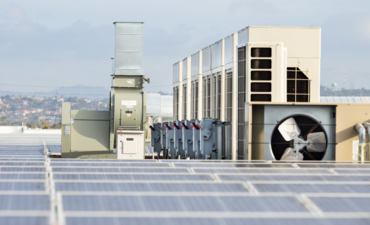
As the energy industry transitions into a new normal, utilities can employ the lessons learned to grow and diversify the company through targeted investments in core markets, utilizing cutting-edge technologies with the potential to restructure the energy ecosystem.
The state of the energy sector
Within the past century, the electric and gas sector have undergone massive transformations due to emerging markets, the evolution of consumers, and disruptive competitors and technologies.
The constitution of our socioeconomic interactions are driven by energy and connectivity. Amid immense market uncertainty, climate change, and technology disruptors, utilities must now focus on basic initiatives that have a targeted and impactful approach to supporting key markets and new technologies.
As the energy industry transitions into a new normal, utilities can employ the lessons learned to grow and diversify the company through targeted investments in core markets, utilizing cutting-edge technologies with the potential to restructure the energy ecosystem.
The energy and utilities segment has traditionally focused on long-term assets like conventional fossil fuel generation while engaging in measured and regulatory constrained shifts in policy. Consequently, utilities' ability to adapt to change have been fragmented and methodical, causing a slow reaction to the future dynamics of the sector.
The path forward
Globally, large utilities are starting to shift investments from conventional power generation and redirecting investments into networks and renewables. Customers are searching for partners to support their energy decision-making, and utilities can step into this role more aggressively. The new market dynamic is driving utilities to create new ideas that deliver, create, and capture value.
Simply providing rate-based service offerings to deliver energy is a thing of the past, as utilities need to start implementing pricing models and services more aligned with prosumers.
To remain competitive, utilities must evaluate the value and the opportunities in areas as diverse as Energy-as-a-Service, the adoption of electric vehicles, and Distributed Energy Generation (DEG). Simply providing rate-based service offerings to deliver energy is a thing of the past, as utilities need to start implementing pricing models and services more aligned with prosumers, and the commercial and industrial sectors.
Customers are discovering how emerging technologies are creating new alternatives and opportunities for improved resiliency, management of their critical facilities, distributed energy monitoring, load management, and sustainability. All these new technologies equate to the customer's ability to understand and control overall energy costs.
A place to start
The distributed generation market is a great place for utilities to start. It will need to coexist with the current grid and generation configurations for the energy landscape of the future to succeed. Key trends driving energy systems into the future include:
- The maturing of renewable energy technologies, coupled with decreasing costs of battery storage technologies
- The emergence of intelligent grids, as smart meter installations increase
- Prosumers moving the utility towards a more decentralized grid with proliferation of distributed generation
The utility market will be faced with devastating consequences if these trends are not addressed and changes are not made. The increased complexity in managing and integrating distributed energy resources will cause utilities to experience their own performance issues as costs to maintain the grid continue to fluctuate.
As new and competitive technologies enter the market and the cost of self-generation technologies decrease, customers will seek non-traditional solutions which, in turn, will decrease the utilities market share, putting pressure on the utilities existing business model.
The changing environment
Customer behaviors are changing as they recognize their ability to control the factors that drive their energy consumption. Prosumers are enabled by the boundless stream of information surrounding cost, equipment, and energy management options, and thusly are more demanding in their preferences and expectations than seen in previous generations.
Utility strategies need to embrace a move from passive interaction to responsive engagement, building anticipation rather than a reaction to customer needs as a response to increased level of customer demand. Utilities can build better expectations by developing offerings and advancing goals that are relevant to the customer, and the customer's energy master plan.
The new market dynamic is driving utilities to create new ideas that deliver, create, and capture value.
Considerable activity has already begun in the energy retail segment, with aggressive growth of new players entering the market and gradually capturing portions of the current utilities business. To be competitive, utilities must actively develop their go-to-market strategy and enter aggressively into the energy services arena.
With the pursuit of 'Behind-the-meter' offerings (BTM), B2B, and B2C products and services in the large commercial and industrial sector, it is essential for utilities to maintain and improve customer stickiness by using these strategies effectively, or they risk losing a large portion of their portfolio in a stable market segment.
As sources of power shift from centralized to distributed, more attention is being focused on the network, where batteries and storage are similarly advancing in economics and performance. Additionally, with the availability of BTM technologies (e.g., controllers, software, and sensors) utilities need to recognize that their role in energy management and intelligence systems is expanding.
Some of the largest U.S. utilities are already actively pursuing growth opportunities, while others are continuing to emphasize traditional resource planning and network modernization through continued capital investment. Fully-integrated utilities must pay more attention to services and solutions through competitive businesses in retail, or work to provide residential, commercial, or industrial services in another format.
For instance, utilities like PG&E, CenterPoint Energy, Consolidated Edison, and National Grid USA are pursuing services and solutions that enhance value for customers in various classes. Whether participating in energy services, small or large DERs, storage, or 'behind-the-meter' value chains, utilities are prime to create new sources of value and capture added profitability.
As the universal drivers of technology and policy force utilities away from their traditional business models and customer behavior thrusts them towards a services and solutions culture, utilities are well-positioned to leverage their customer relationships and unique capabilities to augment their value as a trusted energy advisor.
Business Development Manager
As Business Development Manager, Roxanne Fong leads our growth strategy for the utilities sector by developing partnerships to deliver energy and infrastructure solutions and services. Her previous experience leading the new revenue development business development team for Pacific Gas & Electric (PG&E) led to the implementation of over $300 million in design-build energy projects.




